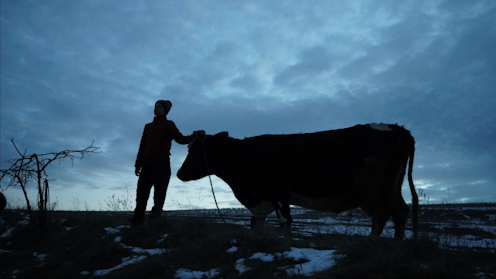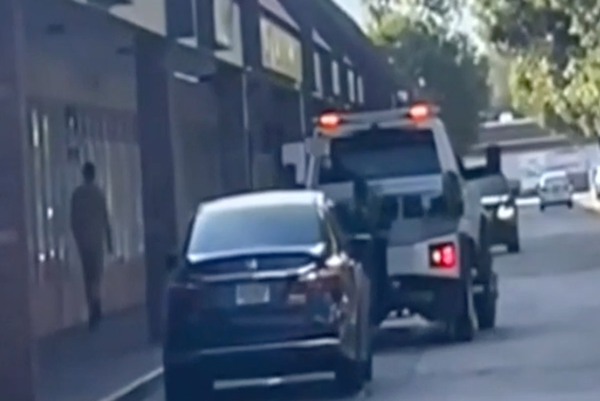
The 2025 Tribeca Film Festival in New York included a world premiere of War Through the Eyes of Animals (also known as Animals in War). The documentary gives an animal-eye view of Russia’s war against Ukraine and features the wartime experiences of several different species, including a cow, a rabbit and a wolf.
Throughout history, animals have been affected by war and exposed to its many dangers. Despite this, war is usually discussed from human-centred perspectives that marginalise animal experiences.
My own work on the Russia-Ukraine war uses sound as a way of thinking about some of the war’s environmental impacts and the experiences of animals. The idea that sound can provide ecological information is not new. Research has shown how the sounds, for example, of plants and animals can tell us a lot about how their environment is changing. What is new is exploring this in the context of war.
For my research project I interviewed more than 30 Ukrainians, including botanists, ornithologists, herpetologists (who study reptiles and amphibians) and a marine biologist. I also asked them to make short recordings of their local soundscapes.
A scientist working in Tuzlivski Lymany National Park in the Odesa region of southern Ukraine made a recording of Iranian Shahed drones flying over his office and explained that these “abnormal” sounds greatly affect some species of birds.
In 2024, for example, there was a large colony of nesting flamingos in Tuzlivski Lymany. However, noise caused them to abandon their nests, leaving their eggs vulnerable to predators. No chicks were born in the flamingo colony that year. Research in peacetime has found that drones can lead to significant breeding failures among some birds.
A herpetologist, meanwhile, shared his recording of natterjack toads and European tree frogs that he made in the Volyn region of northern Ukraine the year before the start of the full-scale invasion in 2022.
What he wanted to convey was that he may never hear this particular “amphibian chorus” again. The area is close to the border with Belarus, and it is unclear what impact the construction of Ukrainian defensive fortifications has had on local animal and plant life.
I also asked interviewees whether the war has helped nature in any way. In response, they frequently talked about reduced anthropogenic (human-made) pressures on the environment. An example is the ban on hunting, first imposed at the start of the war in eastern Ukraine in 2014.
One interviewee recorded a nighttime summer meadow in Kyiv region and captured the distant sound of a fox calling. The prohibition on hunting has enabled foxes to thrive
Another interviewee made a recording near the Kaniv Nature Reserve in central Ukraine. Alongside birdsong are the barking sounds of roe deer, another species that has benefited from the hunting ban.
Of course, such population increases are not necessarily beneficial to wider ecosystems, as ecologist Aldo Leopold discussed in his classic Thinking like a Mountain (1949). Leopold found that uncontrolled numbers of deer due to the mass killing of wolves in the United States during the first part of the 20th century took a huge toll on the environment. “I have seen every edible bush and seedling browsed”, he wrote", “first to anaemic desuetude, and then to death”.
The fact that the Russia-Ukraine war has contributed to reducing some anthropogenic pressures does not in any way minimise the enormity of harm done to nature, including forests, soil and marine ecosystems. Yet it is too narrow to think about the environment only in terms of harms done to it.
Nature’s recovery
The Chernobyl Exclusion Zone (CEZ) created following the Chernobyl nuclear disaster in 1986 is often cited as an example of nature’s ability to recover. One of the ornithologists whom I interviewed made a recording of birdsong from within the CEZ, in northern Ukraine.
When I listen to the recording I am reminded of research which has found that birds have adapted physiologically to radiation exposure within the CEZ.
Another example of recovery relates to the destruction of the Kakhovka dam in June 2023. When Russian aggressors breached the dam, water drained from the Kakhovka reservoir, leaving it dry. Today, there is a young willow forest growing on the site of the former reservoir.
To emphasise the resilience of nature, one of my interviewees made an audio recording from the Yelanets Steppe Nature Reserve in the Mykolaiv region in southern Ukraine. Against the acoustic backdrop of wind gusting through the grasslands are the repeated calls of the common pheasant.
These sounds of the wild steppe awakening in early spring, the interviewee stressed, are also the sounds of nature getting on with life.
Birdsong is clearly audible in a recording made by soldiers near the frontline in Kharkiv region.
Similarly, birds continued to sing over the trenches during the first world war. Some interviewees also pointed out that certain species of birds, including cormorants, herons and white storks, have adapted to the sounds of war, becoming less sensitive to them.
Justice and reparations
I am particularly interested in the significance of nature’s sounds in the context of transitional justice – and especially reparations.
Discourse on environmental reparations focuses on repairing harms done to nature – and sounds can provide useful insights into some of these harms.
But what is missing from existing scholarship on reparations is attention to some of the ways that ecosystems can and do regenerate and recover. Moving forward, therefore, it is essential to think about how reparations can support (and not disturb) these natural ecosystem processes.
Janine Natalya Clark receives funding for this research from the Leverhulme Trust (RF-2024-137)
This article was originally published on The Conversation. Read the original article.







